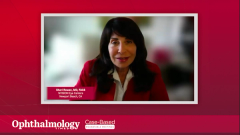
Patient Case No. 2: Managing Dry Eye in a Young Patient Habituated to Contact Lens Wear
An expert examines a case involving a young male patient interested in LASIK treatment but facing meibomian gland atrophy.
Sheri Rowen, MD, FACS: Case 2 [involves] a 26-year-old [man] presenting for LASIK [laser in situ keratomileusis]. First reason I bring this up is that it’s a male [patient]. So we have to get out of our heads that [a patient with] dry eye disease is a perimenopausal female [patient]. We are seeing a lot of men coming in with dry eyes as well. So don’t discount this. And many of the patients who we’re seeing are coming in as contact lens intolerant who are now trying to get LASIK so they can see better without having to wear their contacts. And you can see this patient has worn contacts since age 11. He’s now 26. So he’s had a 15-year history of wearing contacts. He works on the computer all day when he’s home. He also adds to that by playing computer games for hours. So this is the digital device syndrome problem where they don’t blink or blink rate goes down from 22 blinks a minute, normally maybe to 7 or 8 blinks a minute, so they don’t blink as well. And most people who are on computers all day…when you ask patients in your practice, “What do they do?”—a lot of them are on computers all day. And we are seeing this uptick in complaints of dry eye disease. And then they come in to us wanting LASIK because they’re intolerant of their contact lenses. So we have to evaluate them…these young patients, male or female, for dry eye because LASIK as a surgery or any surgery can tip them over, and a lot of them already have dry eyes. When you look at this next slide, this is a 26-year-old patient who came in. It was astounding to me. This was one of my first patients we were examining on our new LipiView device when we got it. And I couldn’t believe the dropout of the meibomian glands at age 26. So we don’t actually look at the LipiView for every case. But what we will do is express every single patient’s glands to make sure we’re seeing normal meibum. So if we don’t see normal meibum coming out, we ask a couple of questions. We say, “Have you ever been on Accutane?” Especially in a patient like this. Because we know that their glands are highly affected when they’ve been on Accutane. We want to know their history. How long have they been in contact lenses? Because we know that is a risk factor for dry eyes. We want to know their lifestyle. Are they on the computer all day? This young [patient] had a lot of problems. I can’t say he was on Accutane, but we do see this in [patients on] Accutane. We always ask it, and we really need to know because if a patient has dry eye preoperatively or signs or symptoms, we really need to tell them so that it’s not on us if they develop dry eye later. [We’ll] say, “Yes, you have dry eye. You were in contact lenses for a very long time. We hope that doing LASIK and getting you out of the contact lenses might improve you,” and then we have to follow them for that if they get a dry eye after LASIK. And speaking of that, we think about dry eye as a neurologic disease and…we know that neurologic has been added to it.
So I want to show you this next slide. And you can see this type of staining pattern that occurs. It’s central. It’s like a band of staining across right below the pupil. And that is a neurotrophic issue. This could be considered a stage 1 neurotrophic keratitis. It could be considered dry eye, and it’s hard to tell. So I recommend that if you ever see this pre- or post surgery, you do corneal sensitivity. Corneal sensitivity should be done in 5 quadrants: central, superior, inferior, nasal, and temporal. And you can tell if somebody has a problem with their nerves here. So sometimes you will see this after LASIK because the nerves don’t always heal the way we expect them to. So we might want to consider nerve growth factor or some other treatments for these patients. Post LASIK, we might have tipped them over. They might have already had components of this. They already might have had dry eye when they’ve come to us. So just be aware of that.
Transcript is AI-generated and edited for clarity and readability.
Newsletter
Don’t miss out—get Ophthalmology Times updates on the latest clinical advancements and expert interviews, straight to your inbox.














































